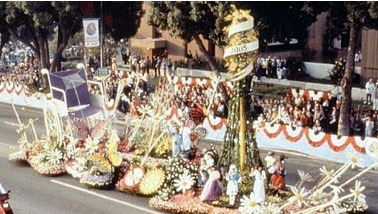Rotarians love to tell stories. They are usually touching and inspirational. They tell of needs and hardships worldwide, experiences Rotarians and others have had, and the wonderful things we have done or plan to do.
With Christmas upon us, the New Year is soon to follow. This brings to mind a story dear to my heart and my inspiration to commit to polio eradication. In the 1986 Tournament of Roses parade, Rotary announced that it was undertaking a campaign to eradicate polio worldwide.
The float depicted an abandoned wheelchair, symbolic of Rotary’s quest for a polio-free world. Youth exchange students in national dress danced around a tree set in a garden of flowers. Atop the tree flew a banner bearing the date of 2005, Rotary’s centennial date, and the target date to have polio gone. A “Stop Polio” symbol, a red circle with a diagonal slash across the word polio, symbolized the float’s theme, Turning Tears to Laughter.
The story was about a courageous young African man, Wilborn Chuvala, riding on the float. He stood on legs supported by braces throughout the three-hour parade, smiling and waving, acknowledging the cheers and thanking Rotary for giving him a new life.
Wilborn’s story was told by Dr. Joe Serra at a President’s Elect Training (PETS) back when I was one of those. Dr. Joe, a Rotarian and Past District Governor from Stockton, CA, was an orthopedic surgeon and team doctor at the University of Pacific. In 1981 he traveled to Lilwongwe the capital of Malawi in SE Africa. Dr. Joe was part of a Rotary team of volunteers sharing their surgical skills to help those afflicted with polio’s crippling effects. He made six such trips overall.
In the early 1960s, when Wilborn was just a year old, he had been infected by the polio virus when it swept through the town of Karonga in northern Malawi. He was left paralyzed from the waist down. Wilborn endured life as a “crawler,” able to move about only on calloused hands and knees.
In 1981 his uncle read about the orthopedic clinic and rehabilitation center in Lilwongwe where the team of Rotarians was operating. The uncle urged his nephew to go with a small bag of food and US$15 given to him by his uncle; the 15-year-old set out alone for the clinic, 270 miles away, first by boat and bus, then by crawling and hitchhiking. Once there, he came under the care of the Rotarians. Dr. Joe operated on Wilborn’s knees and hip and extended his Achilles tendons, enabling the teenager to stand upright, supported by braces, for the first time. Wilborn later wrote to Dr. Joe: “You will be so pleased, as am I, that I walk without a crutch. I walk with a cane now. I walk like a gentleman.”
Rotary invited Wilborn to travel to Pasadena and ride on Rotary’s parade float. With help from British Airways, he made the long flight from Malawi to California to symbolize the hope that this global program of polio immunization would spare millions of children with disabilities such as his. Dr. Joe rode with Wilborn on the float.
Dr. Joe funded Wilborn’s high school and college education. He eventually married and they had two children. He became a math and English teacher, thereby paying it forward. They named their children Joe and Dorothy after Joe and his wife.
As Dr. Joe concluded his story at PETS in 2000, I was sold on the campaign to end polio. In 2004, Leah and I got to participate in a National Immunization Day in India, where we saw the commitment of the country to becoming polio-free. It has been a long, expensive, and tough road, and as the cliché goes, “we are this close.” We are, and we must continue the campaign to the end.





